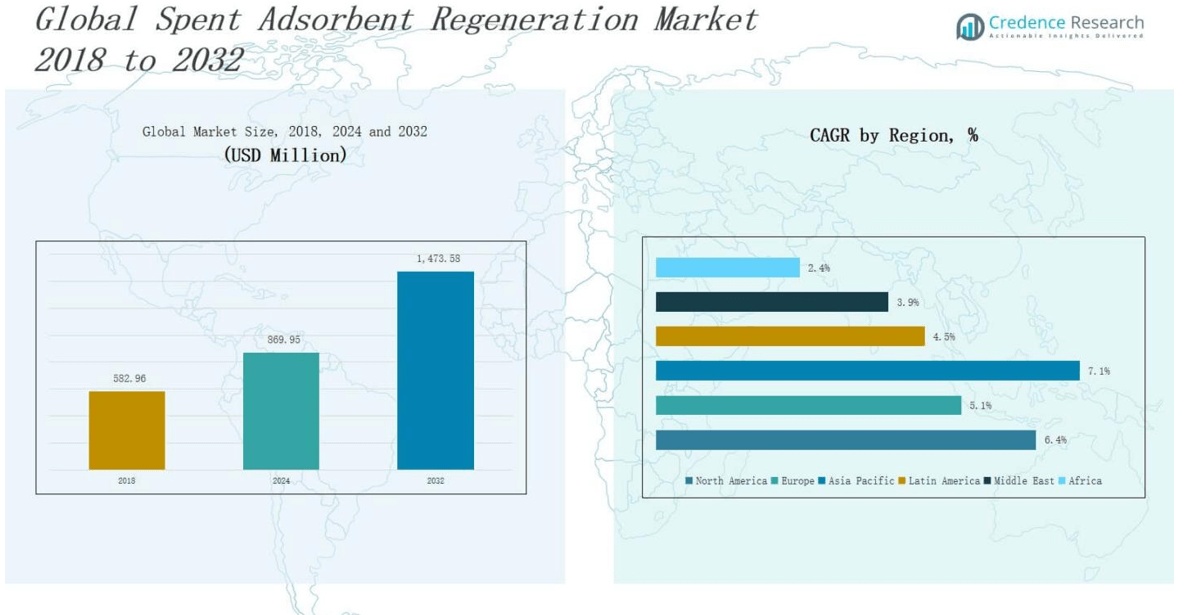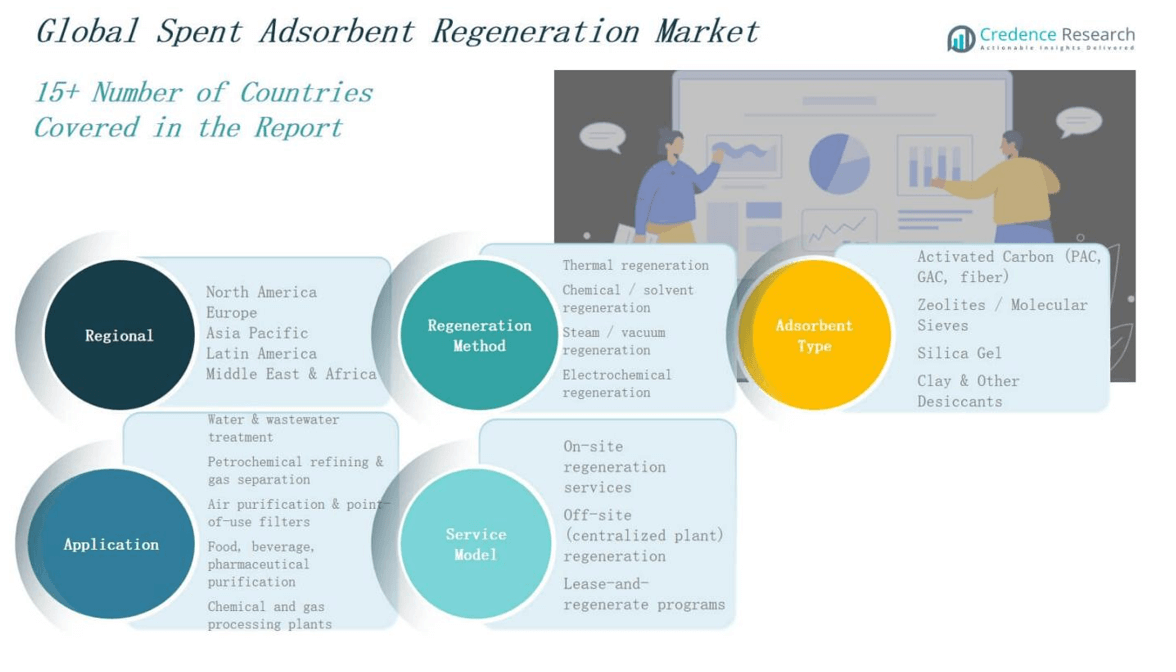CHAPTER NO. 1: GENESIS OF THE MARKET
1.1 Market Prelude – Introduction & Scope
1.2 The Big Picture – Objectives & Vision
1.3 Strategic Edge – Unique Value Proposition
1.4 Stakeholder Compass – Key Beneficiaries
CHAPTER NO. 2: EXECUTIVE LENS
2.1 Pulse of the Industry – Market Snapshot
2.2 Growth Arc – Revenue Projections (USD Million)
2.3. Premium Insights – Based on Primary Interviews
CHAPTER NO. 3: SPENT ADSORBENT REGENERATION MARKET FORCES & INDUSTRY PULSE
3.1 Foundations of Change – Market Overview
3.2 Catalysts of Expansion – Key Market Drivers
3.2.1 Momentum Boosters – Growth Triggers
3.2.2 Innovation Fuel – Disruptive Technologies
3.3 Headwinds & Crosswinds – Market Restraints
3.3.1 Regulatory Tides – Compliance Challenges
3.3.2 Economic Frictions – Inflationary Pressures
3.4 Untapped Horizons – Growth Potential & Opportunities
3.5 Strategic Navigation – Industry Frameworks
3.5.1 Market Equilibrium – Porter’s Five Forces
3.5.2 Ecosystem Dynamics – Value Chain Analysis
3.5.3 Macro Forces – PESTEL Breakdown
3.6 Price Trend Analysis
3.6.1 Regional Price Trend
3.6.2 Price Trend by Regeneration Method
CHAPTER NO. 4: KEY INVESTMENT EPICENTER
4.1 Regional Goldmines – High-Growth Geographies
4.2 Product Frontiers – Lucrative Product Categories
4.3 Application Sweet Spots – Emerging Demand Segments
CHAPTER NO. 5: REVENUE TRAJECTORY & WEALTH MAPPING
5.1 Momentum Metrics – Forecast & Growth Curves
5.2 Regional Revenue Footprint – Market Share Insights
5.3 Segmental Wealth Flow – Regeneration Method & Application Revenue
CHAPTER NO. 6: TRADE & COMMERCE ANALYSIS
6.1. Import Analysis by Region
6.1.1. Global Spent Adsorbent Regeneration Market Import Revenue By Region
6.2. Export Analysis by Region
6.2.1. Global Spent Adsorbent Regeneration Market Export Revenue By Region
CHAPTER NO. 7: COMPETITION ANALYSIS
7.1. Company Market Share Analysis
7.1.1. Global Spent Adsorbent Regeneration Market: Company Market Share
7.2. Global Spent Adsorbent Regeneration Market Company Revenue Market Share
7.3. Strategic Developments
7.3.1. Acquisitions & Mergers
7.3.2. New Product Launch
7.3.3. Regional Expansion
7.4. Competitive Dashboard
7.5. Company Assessment Metrics, 2024
CHAPTER NO. 8: SPENT ADSORBENT REGENERATION MARKET – BY REGENERATION METHOD SEGMENT ANALYSIS
8.1. Spent Adsorbent Regeneration Market Overview by Regeneration Method Segment
8.1.1. Spent Adsorbent Regeneration Market Revenue Share By Regeneration Method
8.2. Thermal regeneration
8.3. Chemical / solvent regeneration
8.4. Steam / vacuum regeneration
8.5. Electrochemical regeneration
CHAPTER NO. 9: SPENT ADSORBENT REGENERATION MARKET – BY ADSORBENT TYPE SEGMENT ANALYSIS
9.1. Spent Adsorbent Regeneration Market Overview by Adsorbent Type Segment
9.1.1. Spent Adsorbent Regeneration Market Revenue Share By Adsorbent Type
9.2. Activated Carbon (PAC, GAC, fiber)
9.3. Zeolites / Molecular Sieves
9.4. Silica Gel
9.5. Clay & Other Desiccants
CHAPTER NO. 10: SPENT ADSORBENT REGENERATION MARKET – BY APPLICATION SEGMENT ANALYSIS
10.1. Spent Adsorbent Regeneration Market Overview by Application Segment
10.1.1. Spent Adsorbent Regeneration Market Revenue Share By Application
10.2. Water & wastewater treatment
10.3. Petrochemical refining & gas separation
10.4. Air purification & point-of-use filters
10.5. Food, beverage, pharmaceutical purification
10.6. Chemical and gas processing plants
CHAPTER NO. 11: SPENT ADSORBENT REGENERATION MARKET – BY SERVICE MODEL SEGMENT ANALYSIS
11.1. Spent Adsorbent Regeneration Market Overview by Service Model Segment
11.1.1. Spent Adsorbent Regeneration Market Revenue Share By Service Model
11.2. On-site regeneration services
11.3. Off-site (centralized plant) regeneration
11.4. Lease-and-regenerate programs
CHAPTER NO. 12: SPENT ADSORBENT REGENERATION MARKET – REGIONAL ANALYSIS
12.1. Spent Adsorbent Regeneration Market Overview by Region Segment
12.1.1. Global Spent Adsorbent Regeneration Market Revenue Share By Region
12.1.2. Regions
12.1.3. Global Spent Adsorbent Regeneration Market Revenue By Region
12.1.4. Regeneration Method
12.1.5. Global Spent Adsorbent Regeneration Market Revenue By Regeneration Method
12.1.6. Adsorbent Type
12.1.7. Global Spent Adsorbent Regeneration Market Revenue By Adsorbent Type
12.1.8. Application
12.1.9. Global Spent Adsorbent Regeneration Market Revenue By Application
12.1.10. Service Model
12.1.11. Global Spent Adsorbent Regeneration Market Revenue By Service Model
CHAPTER NO. 13: NORTH AMERICA SPENT ADSORBENT REGENERATION MARKET – COUNTRY ANALYSIS
13.1. North America Spent Adsorbent Regeneration Market Overview by Country Segment
13.1.1. North America Spent Adsorbent Regeneration Market Revenue Share By Region
13.2. North America
13.2.1. North America Spent Adsorbent Regeneration Market Revenue By Country
13.2.2. Regeneration Method
13.2.3. North America Spent Adsorbent Regeneration Market Revenue By Regeneration Method
13.2.4. Adsorbent Type
13.2.5. North America Spent Adsorbent Regeneration Market Revenue By Adsorbent Type
13.2.6. Application
13.2.7. North America Spent Adsorbent Regeneration Market Revenue By Application
13.2.8. Service Model
13.2.9. North America Spent Adsorbent Regeneration Market Revenue By Service Model
13.3. U.S.
13.4. Canada
13.5. Mexico
CHAPTER NO. 14: EUROPE SPENT ADSORBENT REGENERATION MARKET – COUNTRY ANALYSIS
14.1. Europe Spent Adsorbent Regeneration Market Overview by Country Segment
14.1.1. Europe Spent Adsorbent Regeneration Market Revenue Share By Region
14.2. Europe
14.2.1. Europe Spent Adsorbent Regeneration Market Revenue By Country
14.2.2. Regeneration Method
14.2.3. Europe Spent Adsorbent Regeneration Market Revenue By Regeneration Method
14.2.4. Adsorbent Type
14.2.5. Europe Spent Adsorbent Regeneration Market Revenue By Adsorbent Type
14.2.6. Application
14.2.7. Europe Spent Adsorbent Regeneration Market Revenue By Application
14.2.8. Service Model
14.2.9. Europe Spent Adsorbent Regeneration Market Revenue By Service Model
14.3. UK
14.4. France
14.5. Germany
14.6. Italy
14.7. Spain
14.8. Russia
14.9. Rest of Europe
CHAPTER NO. 15: ASIA PACIFIC SPENT ADSORBENT REGENERATION MARKET – COUNTRY ANALYSIS
15.1. Asia Pacific Spent Adsorbent Regeneration Market Overview by Country Segment
15.1.1. Asia Pacific Spent Adsorbent Regeneration Market Revenue Share By Region
15.2. Asia Pacific
15.2.1. Asia Pacific Spent Adsorbent Regeneration Market Revenue By Country
15.2.2. Regeneration Method
15.2.3. Asia Pacific Spent Adsorbent Regeneration Market Revenue By Regeneration Method
15.2.4. Adsorbent Type
15.2.5. Asia Pacific Spent Adsorbent Regeneration Market Revenue By Adsorbent Type
15.2.6. Application
15.2.7. Asia Pacific Spent Adsorbent Regeneration Market Revenue By Application
15.2.8. Service Model
15.2.9. Asia Pacific Spent Adsorbent Regeneration Market Revenue By Service Model
15.3. China
15.4. Japan
15.5. South Korea
15.6. India
15.7. Australia
15.8. Southeast Asia
15.9. Rest of Asia Pacific
CHAPTER NO. 16: LATIN AMERICA SPENT ADSORBENT REGENERATION MARKET – COUNTRY ANALYSIS
16.1. Latin America Spent Adsorbent Regeneration Market Overview by Country Segment
16.1.1. Latin America Spent Adsorbent Regeneration Market Revenue Share By Region
16.2. Latin America
16.2.1. Latin America Spent Adsorbent Regeneration Market Revenue By Country
16.2.2. Regeneration Method
16.2.3. Latin America Spent Adsorbent Regeneration Market Revenue By Regeneration Method
16.2.4. Adsorbent Type
16.2.5. Latin America Spent Adsorbent Regeneration Market Revenue By Adsorbent Type
16.2.6. Application
16.2.7. Latin America Spent Adsorbent Regeneration Market Revenue By Application
16.2.8. Service Model
16.2.9. Latin America Spent Adsorbent Regeneration Market Revenue By Service Model
16.3. Brazil
16.4. Argentina
16.5. Rest of Latin America
CHAPTER NO. 17: MIDDLE EAST SPENT ADSORBENT REGENERATION MARKET – COUNTRY ANALYSIS
17.1. Middle East Spent Adsorbent Regeneration Market Overview by Country Segment
17.1.1. Middle East Spent Adsorbent Regeneration Market Revenue Share By Region
17.2. Middle East
17.2.1. Middle East Spent Adsorbent Regeneration Market Revenue By Country
17.2.2. Regeneration Method
17.2.3. Middle East Spent Adsorbent Regeneration Market Revenue By Regeneration Method
17.2.4. Adsorbent Type
17.2.5. Middle East Spent Adsorbent Regeneration Market Revenue By Adsorbent Type
17.2.6. Application
17.2.7. Middle East Spent Adsorbent Regeneration Market Revenue By Application
17.2.8. Service Model
17.2.9. Middle East Spent Adsorbent Regeneration Market Revenue By Service Model
17.3. GCC Countries
17.4. Israel
17.5. Turkey
17.6. Rest of Middle East
CHAPTER NO. 18: AFRICA SPENT ADSORBENT REGENERATION MARKET – COUNTRY ANALYSIS
18.1. Africa Spent Adsorbent Regeneration Market Overview by Country Segment
18.1.1. Africa Spent Adsorbent Regeneration Market Revenue Share By Region
18.2. Africa
18.2.1. Africa Spent Adsorbent Regeneration Market Revenue By Country
18.2.2. Regeneration Method
18.2.3. Africa Spent Adsorbent Regeneration Market Revenue By Regeneration Method
18.2.4. Adsorbent Type
18.2.5. Africa Spent Adsorbent Regeneration Market Revenue By Adsorbent Type
18.2.6. Application
18.2.7. Africa Spent Adsorbent Regeneration Market Revenue By Application
18.2.8. Service Model
18.2.9. Africa Spent Adsorbent Regeneration Market Revenue By Service Model
18.3. South Africa
18.4. Egypt
18.5. Rest of Africa
CHAPTER NO. 19: COMPANY PROFILES
19.1. BASF SE
19.1.1. Company Overview
19.1.2. Product Portfolio
19.1.3. Financial Overview
19.1.4. Recent Developments
19.1.5. Growth Strategy
19.1.6. SWOT Analysis
19.2. Honeywell International Inc.
19.3. W.R. Grace & Co
19.4. Cabot Corporation
19.5. Calgon Carbon Corporation
19.6. Clariant AG
19.7. Arkema SA
19.8. Axens
19.9. Zeochem AG
19.10. Adsorbents & Desiccants Corp. of America
19.11. Zeolyst International
19.12. Sorbent Technologies, Inc.
19.13. Mitsubishi Chemical Corporation
19.14. Johnson Matthey
19.15. UOP LLC (Honeywell UOP)









